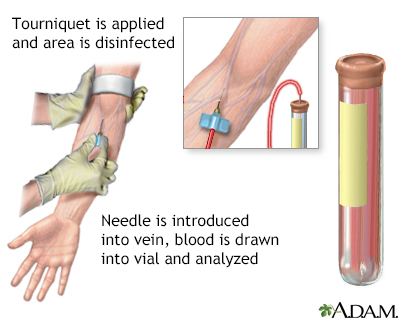Drawing more than the recommended amount of an infant's blood volume may result in which of the following conditions?
Pernicious anemia
Iatrogenic anemia
Hyperthermia
Hypothermia
The Correct Answer is B
Choice A Reason:
Pernicious anemia is a type of anemia caused by a deficiency of vitamin B12, which is not directly related to the volume of blood drawn. It is typically associated with the inability to absorb vitamin B12 from the gastrointestinal tract and is not a consequence of drawing blood.
Choice B Reason:
Iatrogenic anemia is the correct answer. It is a condition that can occur when too much blood is drawn from an infant, leading to anemia caused by medical intervention. Infants have a limited blood volume, and removing more than the recommended amount can significantly decrease their red blood cell count, resulting in anemia.
Choice C Reason:
Hyperthermia refers to an abnormally high body temperature, which is not a direct result of drawing blood. It is more commonly associated with environmental factors, infections, or other medical conditions that cause the body's temperature regulation to fail.
Choice D Reason:
Hypothermia is a condition where the body temperature drops below the normal range, which is also not a direct consequence of drawing blood. It is typically caused by prolonged exposure to cold temperatures and is unrelated to the volume of blood drawn from an infant.
Nursing Test Bank
Naxlex Comprehensive Predictor Exams
Related Questions
Correct Answer is B
Explanation
Choice A reason:
The date of birth is a common identifier, but it is not unique to an individual, as multiple patients may share the same birth date. While it is useful in conjunction with other identifiers, on its own, it does not provide a definitive identification.
Choice B reason:
The record number, often referred to as the medical record number, is a unique identifier assigned to each patient within a healthcare system. It is used to track patient information across different visits and services, making it the most reliable standalone identifier if the patient's name is not available.
Choice C reason:
An address can change over time and may not be unique, especially in large apartment buildings or for patients who are homeless or transient. It is also not specific enough to reliably identify a patient, as multiple individuals can reside at the same address.
Choice D reason:
The social security number is a unique identifier, but due to privacy concerns and the risk of identity theft, it is not the preferred method for patient identification in healthcare settings. Additionally, not all patients may have a social security number, such as non-residents or newborns.
Correct Answer is C
Explanation
Choice A reason:
Simply observing the site to see if the hematoma worsens is not an appropriate response. While monitoring the development of a hematoma is part of the process, it is not a proactive measure to address the immediate issue. The phlebotomist must take action to prevent further injury or complication.
Choice B reason:
Asking the patient to apply pressure may be part of the post-venipuncture care, especially after the needle has been removed, to aid in stopping any bleeding. However, this does not address the immediate concern of a developing hematoma during the draw.
Choice C reason:
Releasing the tourniquet and stopping the draw is the correct action to take when a hematoma is observed. This response is in line with the standard procedure for when a complication arises during venipuncture. Stopping the draw helps prevent further blood from pooling and exacerbating the hematoma.
Choice D reason:
While calling for a nurse and assessing the patient's condition is important, especially if the phlebotomist needs assistance or the patient shows signs of distress, it should not be the first action taken. The immediate response should be to address the hematoma by stopping the draw.

Whether you are a student looking to ace your exams or a practicing nurse seeking to enhance your expertise , our nursing education contents will empower you with the confidence and competence to make a difference in the lives of patients and become a respected leader in the healthcare field.
Visit Naxlex, invest in your future and unlock endless possibilities with our unparalleled nursing education contents today
Report Wrong Answer on the Current Question
Do you disagree with the answer? If yes, what is your expected answer? Explain.
Kindly be descriptive with the issue you are facing.
